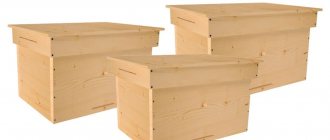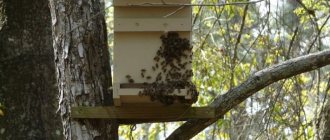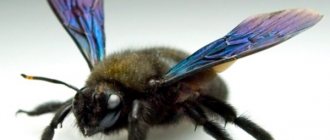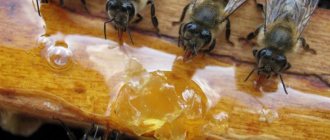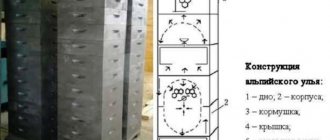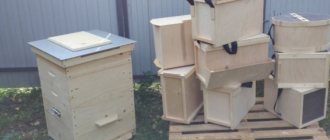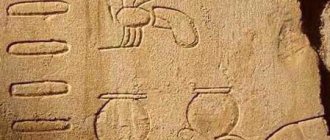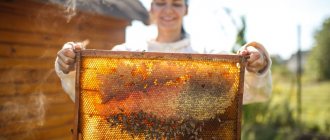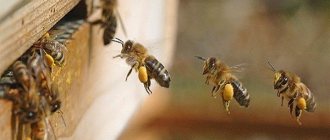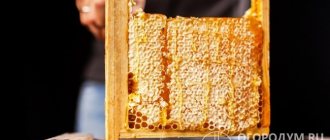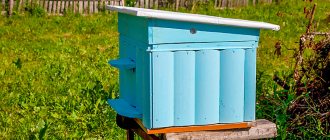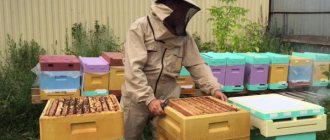Beekeeping is constantly undergoing updates and the introduction of new technologies, improved products and designs that are designed to make the process easier. One of these new products was the horned hive. Its inventor and active advocate was Mikhail Palivoda. He recommends it in cases where the apiary is aimed at industrial honey production. But, before choosing just such a design for your farm, you need to understand its advantages and disadvantages, design features and the specifics of keeping bees.
What are the benefits
The Palivoda hive (also called the horned structure of an insect house) has the following advantages:
- You can install various types of frames in it, both purchased in a store and made with your own hands for a Dadanovsky hive.
- You can make a horned hive with your own hands. The simplicity of the design allows this to be done even by those who have no experience in carpentry.
- As the main material, you can use lining with a thickness of no less than 25 mm and sufficiently well dried. These conditions help prevent the spread of fungal infections within the hive.
- If there are no planed boards or linings, any wood scraps will do. The structure can be assembled at minimal cost.
- To implement it yourself, you don’t have to acquire a special tool.
- The standard Palyvoda horned hive holds 8 frames of a standardized size. Their dimensions are 435 mm and 145 mm. Can be used in nucleus type hives.
- The cost of production is low, so it is affordable for beginning beekeepers.
- Weight including frames does not exceed 16 kg. as a result, such a house can easily be moved by one person without much effort, which makes work in the apiary easier.
Manufacturing nuances
It is not necessary to completely copy the finished drawing of the hive. You can combine successful devices of different designs, for example, use a high bottom using German technology. The same decision is radically changed by small nuances - whether or not to make holes for tap holes in the housings, use a blind or mesh bottom, etc.
The most popular material for making hives is undoubtedly wood.
It is important to consider its moisture content before constructing the evidence. According to GOST, it should not exceed 15%
If the moisture content is high, the structure will inevitably move and the dimensions of the board will change.
Equipment
The house includes:
- The body itself is like a frame element to which all other parts are attached.
- The bottom bottom is made solid.
- The second bottom, which has a mesh through which debris falls through and does not accumulate directly in the hive. This allows you to keep the insect house clean.
- A plane that acts as a roof. It is made of galvanized steel and matches the dimensions of the main body. To ensure reliable temperature conditions, foam is used as insulation.
- Frames with a size of 145 mm.
Horned hive: how to make it yourself, structural features, drawings, photos, videos
Among the many designs of hives, beekeepers distinguish the stag hive. This is a simple bee house that is easy to build with your own hands. Read on for information on material requirements and assembly features.
Equipment
The assembled hive consists of the following parts:
- housing blocks;
- bottom (solid or mesh);
- ceiling frame.
Learn how to make your own polystyrene foam beehives.
A hive can have any number of blocks. Typically, beekeepers prefer to make 5-7-case stag hives. Hundred frames are placed in each block. At the bottom of the hive there should be an entrance - a hole for the bees to fly out. The slot can be equipped with a latch, which will allow you to close the tap hole if necessary.
DIY assembly features
The stag hive is simple to assemble, so it is easy to assemble it with your own hands. Before designing, the beekeeper needs to decide on the size and materials. Based on them, the beekeeper draws a drawing.
Selecting dimensions and creating a drawing
A standard block for a horned hive holds 8 hundred frames. However, this is only a type of construction. If you design it yourself, you can create drawings for 10 frames, which is advantageous for many beekeepers. You can also think of blocks for different sizes of honeycomb frames and build a hive for a 230- or 145-mm frame.
The dimensions of the hive for 8 frames 145 mm are as follows.
Frame:
- four bars for the horns - 150x22x27 mm;
- two side walls - 155x540x22 mm;
- two end walls - 155x300x20 mm.
Bottom:
- two side walls - 540x100x22 mm;
- end wall – 300×78×22 mm;
- two bars - 344x22x22 mm;
- four horns - 22x22x95 mm;
- metal mesh with cells 3x3 or 4x4 - 300x450 mm.
We recommend learning how to make a 10-frame hive with your own hands.
Frame cover:
- side walls - 540x50x22 mm;
- end walls - 300×50×22 mm;
- four connecting bars - 27x22x80 mm;
- three boards per lid - 344x180x12 mm.
Step-by-step instruction
Assemble the stag hive sequentially. First, construct the body, then the bottom and the frame-cover. For assembly, in addition to the wooden elements, prepare a set of materials and tools:
- machine;
- self-tapping screws;
- screwdriver;
- clamp;
- hammer.
It is preferable to carry out the work on a wood milling machine.
Assembly of the case
The step-by-step instructions for assembling the case are as follows.
- Cut folds measuring 10x10 cm in the upper parts of the end walls along the entire length. Frames for bees are subsequently installed on them.
- Attach the antlers with self-tapping screws to the front and back walls. The horn bars should protrude 5 mm over them.
- Screw the side walls to the horns and end parts with self-tapping screws. At the top and bottom they should be on the same level as the end ones. The horns are located in the corner between the side and end walls on the outside.
- To ensure that the elements fit tightly together, tap with a hammer. Use a clamp as a clamp.
Bottom assembly
The bottom should be assembled this way.
- On one side of each side wall, cut 22x24mm folds along the sides.
- Using a clamp and self-tapping screws, connect the side walls to the end.
- According to the drawing, attach two bars to the side walls. This creates a hole for ventilation.
- Screw the horns onto the self-tapping screws so that they protrude 17 mm above the side walls.
- Attach a mesh bottom at a height of 22 mm from the bottom. For fastening, you can use bars according to the size of the walls.
Frame assembly
Assemble the frame cover in this way.
- Connect the side and end beams.
- Secure the blocks in the corners using self-tapping screws. It is convenient to use trimmings from the horns that remain when constructing the cases.
- Attach boards over the entire area - they will serve as a roof.
- For insulation, cover the inside of the lid with foamed polyethylene. You can also use a moss pillow sewn to fit the size of the lid.
Important! To protect from bad weather, beekeepers cover the outer part of the lids with aluminum sheets. They are convenient to attach to brackets. Horned hives are easy to move, and the blocks are interchangeable - which is why many beekeepers prefer this design
If you have the materials, tools and drawings, it’s easy to assemble stag hives yourself
Horned hives are easy to move, and the blocks are interchangeable - which is why many beekeepers prefer this design. If you have the materials, tools and drawings, stag hives are easy to assemble yourself.
Peculiarities
Among the features that distinguish such a horned house for bees are:
- Small format, which makes it easy to handle the product even for inexperienced novice beekeepers.
- Good ventilation, which makes it possible for the bees not to overheat during the hot summer months.
- They are easily installed on a platform for organizing a nomadic apiary.
- It is easy to treat the inside of such a house against parasites, including varroa mites.
- Easy to handle for novice beekeepers.
And now, in order, about the merits of each of the elements of this hive
1. The detachable bottom has a full-width notch, which allows you to effectively ventilate the nest in hot weather.
Advantages:
a) allows you to control the shedding of ticks after treatment (remove the body, place a clean sheet of white paper on the bottom and the next day count the number of fallen ticks);
b) allows you to control the progress of wintering (during the winter season, if there is a positive temperature outside (in the pavilion), they remove the body and, using the crumbs from the printed combs, determine how the club is moving and where it is going, and also determine the quantity and quality of food);
c) reduces the time for inspection and cleaning in the spring (the whole operation boils down to removing the body and installing it on a previously prepared clean bottom).
A possible drawback may be the lack of a mesh that allows you to further regulate the temperature in the nest.
2. Case with a frame size of 145 mm.
Advantages:
a) ease of manufacture (four calibrated boards are fastened at the corners with obligatory gluing with waterproof glue at the ends). If the boards are made exactly to size, then no template is needed to fasten them together. The side walls of each case have sinks (recesses) for removal and installation;
b) versatility when using frames with sizes of 145 and 300 mm (if you install ten frames of 145 mm, you get one body, if you connect two bodies, you get ten frames of 300 mm);
c) transition to keeping bees from a frame with a height of 300 mm to a frame with a height of 145 mm and vice versa;
d) the force applied when changing honey cases is minimal in relation to working with cases of 230 and 300 mm (when my case is completely filled with honey, its weight is 18-20 kg, and the weight of a full frame is about 2 kg. Similar cases of larger sizes weigh twice as much, 38-40 kg, plus the greater weight of the body itself);
e) the ability to work with bodies rather than frames (the technology for working with multi-body hives is described in the literature);
f) having a sufficient number of buildings in the apiary, made strictly to size, there is no need to worry about their replacement, rearrangement and transportation;
g) the possibility of increasing the under-frame space to the size of the housing during wintering (the family winters on 10 frames 300 mm high or 20 frames 145 mm high in two buildings; if necessary, an empty housing is installed between the nest and the bottom). A large sub-frame space improves the air exchange of the hive, which has a beneficial effect on the progress of wintering;
h) the presence of round entrances, made at an angle to the horizon to prevent rainwater from flowing into the hives and equipped with entrance barriers, allows you to additionally regulate the temperature in the nest, as well as use each body as a nucleus;
i) the possibility of increasing hives from 6 to 12 buildings to form honey families.
I haven't found any flaws with this case yet.
3. There is not much to say about the separating grid. As you know, it serves to separate the brood body from the honey ones. It is a regular Hahnemann lattice, framed in a special frame for precise articulation of the bodies.
4. The bee remover is used to remove bees from the upper honey housings. It is installed in the cut between the upper housing with honey (which needs to be pumped out) and the housings that are located below. The action of the bee remover is based on the passage of bees from the upper body to the lower one, but not from bottom to top. The Quebec remover has an advantage over the Porter remover, because it has no rubbing mechanical parts.
5. The lid is a reduced-size body with a solid bottom, in which two holes are cut for the passage of bees to the feeder, and replaces the ceiling of a conventional hive.
READ ALSO: AYSIDIVIT
6. The nomadic mesh is installed on the upper bodies when transporting hives, as well as for additional ventilation of the hives in the pavilion. At the same time, the liner is removed.
7. The feeder is installed in the roof liner, having previously removed the plugs from it. The feeder is made of polystyrene, which makes it easy to clean and sterilize.
8. The flat roof is made to fit the body and covered with galvanized iron sheets. The insulation is 20-30 mm polystyrene foam.
9. Frames 145 mm high with permanent dividers, 10 mm thick block.
Assembling the Horned Hive
To assemble such a hive with your own hands, you must adhere to the following sequence of actions:
- There is no need to process the boards. It is enough that there are no hard burrs or knots on them.
- It is necessary to knock four boards together so that they form a rectangle.
- The fastenings are special bars that protrude upward beyond the resulting frame by approximately 22 mm.
- The bottom will be double. In this part of the product, a notch is made - a hole so that insects can freely leave the house and return to it with the harvested crop.
- The upper bottom is made of fine-textured mesh. It ensures the settling of all debris that is formed during the life of insects. This way the house remains clean all the time and parasites do not spread.
- The second bottom is made solid and all the waste products of bees are collected in it. It is easy to pull it out of the structure and pour out everything that has accumulated for cleansing.
- After the bottom is completed and the tap hole is drilled in it, it is necessary to begin assembling the fixing frame, which is installed as a roof.
- After completing this step, you need to coat the product with paint to form a protective layer.
- Keep in mind that in the middle zone and to the north, bee houses have to be insulated with polystyrene foam so that the insects emerge in the spring in a healthy and strong condition.
This is how one of the buildings is made. And since there will be several of them, it is possible to fix them together with special bars. It doesn’t matter what size and evenness they are. Thanks to such an unpretentious design of the Palivoda horned hive, it has become so beloved by many beekeepers. After all, no special requirements are placed on her. In addition, with the correct arrangement of all elements, a gap for the tap hole will immediately form and it will not have to be cut out additionally later.
Worker bees and drones. Characteristics and functions in the family
All worker bees of the community are female. They number up to 90 thousand during the honey harvest period and up to 40 thousand in the off-season. Worker bees have underdeveloped reproductive organs and cannot lay eggs.
Functions of working insects:
- search for plants;
- nectar collection;
- caring for offspring;
- control of the sanitary condition of the hive;
- maintaining the required level of humidity;
- honeycomb construction;
- heating and protection of the nest.
The old worker bees are busy all the time. One group of young bees works only at night. The other is during the day. New individuals perform internal work. Adults are outside the nest. They make excellent defenders.
In order not to provoke attacks from aggressive defenders, you need to know a few points. Bees are highly irritated by odors:
- the smell of sweat, perfume, alcohol;
- animals;
- bee venom.
Males have a number of differences:
- wax glands are absent;
- no facilities for collecting pollen;
- there is no sting.
Drones don't build honeycombs. They are not adapted for collecting food and cannot feed themselves. They will not be able to provide themselves with protection. The only and main function of males is to mate with the queen bee.
Worker bees take care of drones during the active breeding season. In the fall, honey plants stop feeding them and drive them out of the family. Therefore, they rarely survive until the cold weather. This is possible in a nest where the queen bee is absent.
Using the bottom
The use of the bottom is very rational. On the one hand, the removable option allows:
- Promptly clean up all fallen elements formed during the life of insects.
- Carry out additional antiparasitic treatment without much effort and disassembling the entire structure.
This is how the hygienic function of such a design is achieved.
On the other hand, the specific bottom can be removed in the hot season and only a mesh element can be left at the bottom of the structure. This allows you to achieve a high level of aeration and cooling of the inside of the house by providing fresh air. It is this state, when ventilation is enhanced, that allows the bees to concentrate on extracting honey, rather than clustering along the front wall of the house.
With minimal disruption to the rhythm of insect life, you can perform all the necessary manipulations that a beekeeper must carry out throughout the year to care for his apiary.
With this design, in order to clean the bee house, it is enough to pull out the lower part and, taking out the mesh, shake out the remains of the bees’ vital activity. Periodically passing through disinfection compounds.
What is the weekend method
Anyone interested in beekeeping, the weekend method, horned hives and other features of keeping bees evaluate any option in terms of labor costs. Often the weekend method is considered frivolous. It is suitable mainly for amateurs, and not for those who do this on an industrial basis.
Hive Dadan
What is special about this kind of beekeeping? As a rule, the owner is not often at the apiary; sometimes he can visit it only once every two weeks. But he needs to know about swarming in advance. In a system such as horned hives, as already noted, there is no frame inspection, but you can immediately lift the body section, and this must be done.
It is also necessary to expand this structure vertically. Moreover, the technology for assembling a horned hive allows this to be done. The Hahnemann grid plays an important role as it allows control of the queen functions and prevents uneven seeding between body sections. The latter is considered unacceptable, since it leads to a deterioration in the quality of honey and to the destruction of the brood during pumping.
Note! If the beekeeper chooses a two-story system for keeping bee families, then instead of a dividing mesh, plastic film is used
When it is installed directly under the roof, the bees will “store” propolis on it, so that it will be easier to collect, and for the weekend method this is very important. Not to mention the fact that such a film rises easier than traditional canvas
Not to mention the fact that this film lifts up easier than traditional canvas.
Thus, although horned hives were not originally designed for the weekend technique, they are quite suitable for the techniques used in this case.
0 0 votes
Article rating
Keeping bees
But still, despite the seemingly continuous advantages, before purchasing or creating a horned hive with your own hands, it is necessary to study all the features of keeping bees in it.
Here are the recommendations given by experienced beekeepers who use the Palivoda horned hive in their apiary:
- When the bribe is intense enough, the insects will be able to build approximately 6 buildings filled with dry matter. In this case, you need to set up to 12 frames so that they have enough area to form honeycombs.
- Thus, the collection of beebread increases.
- In this version of the hive, honey will be stored in the lower sections, while the queen with brood will be located in the upper two buildings.
- During the season when pollen is produced in abundance on the trees, 10 days will be enough for bees to fill about 8 frames with beebread.
Techniques of experienced beekeepers
Multi-body hive Ruta
preparation for the winter monthsThe best option is feeding with sugar
Commercial beekeepers produce honey throughout the summer. They contain the uterus in a lower body, which is delimited by a dividing lattice. It is called the brood chamber. An ordinary bee can pass through the grate, but the queen, due to her size, cannot pass there.
Beekeepers who abandoned Dadan hives in favor of Rutov hives are advised to place a bee package of the Rut system and a frame of the Dadan system during the transition period. Simply put, during the transition period, the hive body is placed on the Dadan frame, and the roof cover is usually placed underneath. Over time, the Dadan frame is trimmed or simply thrown away.
There are several more rules that help novice beekeepers avoid mistakes. They do not depend on the type of hive you have chosen:
- The space between the housing wall and the side frame strip cannot be made less than 7 mm. Otherwise, you risk crushing the bees when removing the frame. The insects will be irritated and may sting you.
- A distance between the bar and the wall that exceeds 12-15 mm is dangerous because this gap will be enough for the bees to create miniature honeycombs that will connect the hive frame to the wall;
- 3. It is not recommended to make the distance between frames from different frames more than 7 mm and less than 5 mm, since the bees will fill this gap with honeycombs or seal it with propolis. As a result, removing the frame and returning it to its place will be extremely problematic. The same distance is not made more than 8-10 mm, so that the bees do not build honeycombs across the frames.
Seasonal work
The normal lifestyle of insects in an apiary requires constant participation and control from the beekeeper. Care does not stop either in winter or in summer. Here are the methods and seasonal work experienced beekeepers use:
- In early spring, check the bottom. This way you can control the temperature and how well the family is developing.
- Inspect the settlement for the presence of parasites. If, for example, varroa mites or any other mites are found, then measures must be taken to destroy them.
- If the hive is clean, then preventive antiparasitic measures are carried out.
- To help expand and strengthen the insect family, it is necessary to rearrange the internal sections and frames.
- In the summer, during intensive honey harvesting, you will have to add an additional section, building the house in height. This is to provide additional frames for the bees to fill with honey.
- If this is not done, then the opportunity to collect a larger number of different types of apiproducts will be missed. And the chances for a full supply of honey for the bee colony for the winter are reduced. This manipulation will allow for complete pumping of honey.
- When the last harvest is carried out, this usually happens no later than mid-August, the depleted combs can be placed in the upper part of the nest. Here they are aged until approximately September. After this, they will need to be stored in a suitable room.
Worker bees and drones. Characteristics and functions in the family
A healthy “queen” of a hive is the only individual capable of laying fertilized eggs. There can be up to several thousand of them per day. The laying process begins at the end of winter and continues until autumn frosts. The first two years are considered the most fertile for the “main individual of the hive.” Subsequently, the masonry is reduced. Many unfertilized eggs appear.
The "queen" is much larger than other insects. It usually weighs up to 300 mg. The young mother is ready to mate by the end of the first week after emerging from the queen cell.
If for some reason there is no contact with males, then she remains infertile. There is a risk of family death.
If the female is healthy, then by the first mating flight the glands begin to work. Substances with a specific odor attract drones. The queen can lay up to 200 thousand eggs per season.
Finding it inside the hive is quite difficult. There are always nurses around her. Caring bees surround the female and close her in a circle. Everyone's heads are turned towards the object of attention and care. The place where she is cared for is built especially for her. On every flight, she must be accompanied by a “retinue”.
In order to avoid inbreeding, the female, following her instincts, flies away from her “home”. Mating must occur with several drones. A diverse set of chromosomes significantly increases the viability of the family. The sperm is collected in the semen collector. It is spent gradually on fertilization of the clutch.
The female should not allow other bees in the family to lay eggs. It is for this purpose that pheromones are released from special glands. She lubricates herself with this product. When cleaning it, worker bees pass it on to each other, exchanging food. The substance affects the hormonal system and blocks the possibility of laying. And not only. The entire swarm acquires a “common” smell.
If there is a problem with the queen, the bees find out about it within a few minutes and begin to get nervous. Community members can quickly calm down if there is a queen cell in the “house”. In its absence, an emergency process of fattening the new “queen” is launched. The beekeeper must carefully monitor the state of the family climate. Because a swarm left without a female and fertilized eggs may die in 2-3 weeks.
All worker bees of the community are female. They number up to 90 thousand during the honey harvest period and up to 40 thousand in the off-season. Worker bees have underdeveloped reproductive organs and cannot lay eggs.
Functions of working insects:
- search for plants;
- nectar collection;
- caring for offspring;
- control of the sanitary condition of the hive;
- maintaining the required level of humidity;
- honeycomb construction;
- heating and protection of the nest.
In order not to provoke attacks from aggressive defenders, you need to know a few points. Bees are highly irritated by odors:
- the smell of sweat, perfume, alcohol;
- animals;
- bee venom.
Males have a number of differences:
- wax glands are absent;
- no facilities for collecting pollen;
- there is no sting.
Drones don't build honeycombs. They are not adapted for collecting food and cannot feed themselves. They will not be able to provide themselves with protection. The only and main function of males is to mate with the queen bee.
Worker bees take care of drones during the active breeding season. In the fall, honey plants stop feeding them and drive them out of the family. Therefore, they rarely survive until the cold weather. This is possible in a nest where the queen bee is absent.
